
WHAT YOU SHOULD KNOW ABOUT REFRIGERATED GOODS TRANSPORTATION
Transporting refrigerated goods presents numerous challenges for logistics companies as well as shippers. Due to the specific requirements of advanced preservation technology, high costs, and the difficulty in monitoring the quality of goods over long distances, this process demands special attention. Let Smart Link guide you through the methods and procedures for this type of cargo transportation.
What is Refrigerated Goods Transportation?
Refrigerated goods transportation is the process of moving products that need to be stored at low temperatures from one place to another. This requires specialized vehicles and equipment to maintain a stable temperature throughout the transport process, ensuring the quality of the goods.

Why is Refrigerated Goods Transportation Important?
- Preserving quality: It helps retain the product’s original quality, taste, and nutritional value.
- Expanding markets: Allows goods to be transported over long distances, meeting the demand of consumers in various regions.
- Ensuring food safety: Prevents bacterial growth, ensuring the health and safety of consumers.
- Optimizing the supply chain: Helps businesses manage their supply chain effectively, minimizing losses.
Key Considerations for Transporting Refrigerated Goods
- Choosing the right transportation mode: Options include refrigerated trucks, containers, ships, and airplanes with advanced temperature control systems.
- Proper packaging: Use specialized, well-insulated packaging that ensures airtightness and protection against impacts.
- Continuous temperature control: Monitor and record the temperature throughout the transportation process, ensuring it remains stable within the permissible range.
- Follow transportation protocols: Load and unload goods quickly, minimize the time the cold storage doors are open, and maintain food safety standards.
- Select a reputable carrier: Choose a carrier with experience, modern equipment, and professional operational procedures.
Popular Forms of Refrigerated Goods Transportation
Road Transportation
- Refrigerated trucks: This is the most common method for short and medium-distance routes. Refrigerated trucks are equipped with specialized cooling systems that help maintain a stable temperature in the cargo hold.
- Refrigerated containers: These containers are used for transporting large volumes of goods over long distances. They are equipped with powerful cooling systems that can maintain stable temperatures over extended periods.
Air Transportation
- Cargo planes: This method is often used for transporting high-value goods that require fast shipping, such as fresh seafood or pharmaceuticals.
- Advantages: The fastest transport time.
- Disadvantages: The highest transport costs and limited cargo volume.
- Best for: Urgent, high-value, low-volume refrigerated goods.
Sea Transportation
- Refrigerated container ships: This method is commonly used to transport large volumes of refrigerated goods on international sea routes.
- Advantages: Low transport costs and the ability to move very large volumes of goods.
- Disadvantages: Long transport times.
- Best for: Exporting and importing large volumes of refrigerated goods.
Conclusion
We have provided comprehensive information on refrigerated goods transportation for your reference. Smart Link Logistics believes that this knowledge will be helpful as you explore the logistics field. With over 13 years of experience in the transport industry, we are committed to partnering with our customers, offering the most optimal solutions for bringing your goods to international markets.
Hotline: + 84 935 766 039 to know more about our services

If you require assistance with international import and export of goods, please contact our team at Smartlink Logistics. We are available to provide you with professional guidance on our services and the necessary customs procedures.
SMART LINK: BEST SERVICE BEST YOU


































